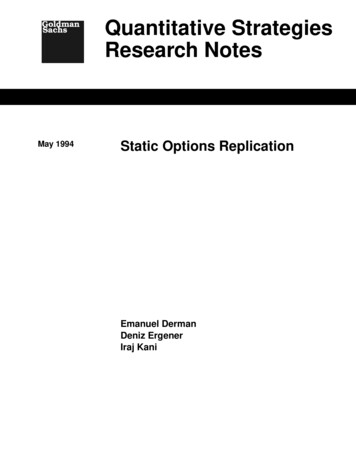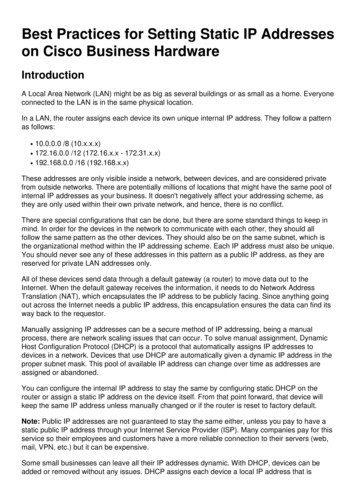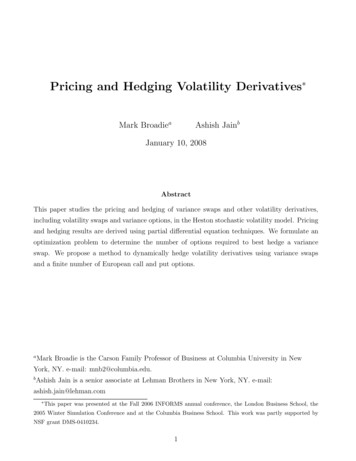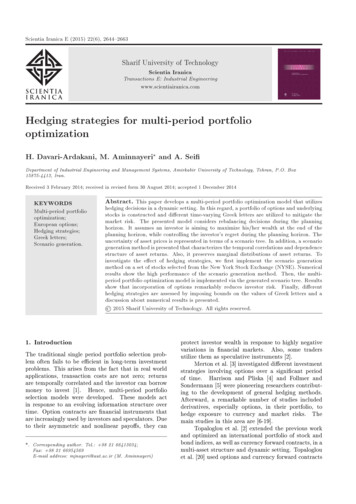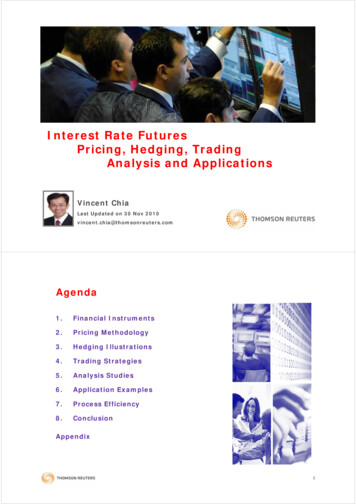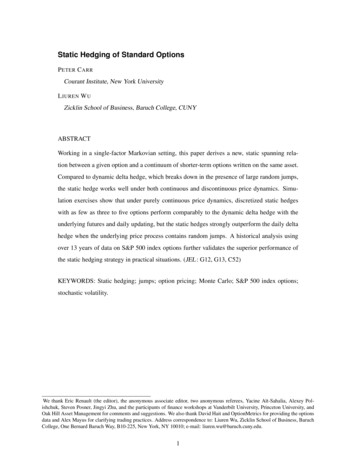
Transcription
Static Hedging of Standard OptionsP ETER C ARRCourant Institute, New York UniversityL IUREN W UZicklin School of Business, Baruch College, CUNYABSTRACTWorking in a single-factor Markovian setting, this paper derives a new, static spanning relation between a given option and a continuum of shorter-term options written on the same asset.Compared to dynamic delta hedge, which breaks down in the presence of large random jumps,the static hedge works well under both continuous and discontinuous price dynamics. Simulation exercises show that under purely continuous price dynamics, discretized static hedgeswith as few as three to five options perform comparably to the dynamic delta hedge with theunderlying futures and daily updating, but the static hedges strongly outperform the daily deltahedge when the underlying price process contains random jumps. A historical analysis usingover 13 years of data on S&P 500 index options further validates the superior performance ofthe static hedging strategy in practical situations. (JEL : G12, G13, C52)KEYWORDS: Static hedging; jumps; option pricing; Monte Carlo; S&P 500 index options;stochastic volatility.We thank Eric Renault (the editor), the anonymous associate editor, two anonymous referees, Yacine Aı̈t-Sahalia, Alexey Polishchuk, Steven Posner, Jingyi Zhu, and the participants of finance workshops at Vanderbilt University, Princeton University, andOak Hill Asset Management for comments and suggestions. We also thank David Hait and OptionMetrics for providing the optionsdata and Alex Mayus for clarifying trading practices. Address correspondence to: Liuren Wu, Zicklin School of Business, BaruchCollege, One Bernard Baruch Way, B10-225, New York, NY 10010; e-mail: liuren.wu@baruch.cuny.edu.1
Over the past two decades, the derivatives market has expanded dramatically. Accompanying this expansion is an increased urgency in understanding and managing the risks associated with derivative securities.In an ideal setting under which the price of the underlying security moves continuously (such as in a diffusion with known instantaneous volatility) or with fixed and known size steps (such as in a binomial tree),derivatives pricing theory provides a framework in which the risks inherent in a derivatives position can beeliminated via frequent trading in only a small number of securities.In reality, however, large and random price movements happen much more often than typically assumedin the above ideal setting. The last two decades have repeatedly witnessed turmoil in the financial marketssuch as the 1987 stock market crash, the 1997 Asian crisis, the 1998 Russian default and the ensuing hedgefund crisis, the tragic event of September 11, 2001, and the most recent financial market meltdown. Juxtaposed between these large crises are many more mini-crises, during which prices move sufficiently fast so asto trigger circuit breakers and trading halts. When these crises occur, a dynamic hedging strategy based onsmall or fixed size movements often breaks down. Worse yet, strategies that involve dynamic hedging in theunderlying asset tend to fail precisely when liquidity dries up or when the market experiences large moves.Unfortunately, it is during these financial crises such as liquidity gaps or market crashes that investors needeffective hedging the most dearly.Perhaps in response to the known deficiencies of dynamic hedging, Breeden and Litzenberger (1978)(henceforth BL) pioneered an alternative approach, which is foreshadowed in the work of Ross (1976)and elaborated on by Green and Jarrow (1987) and Nachman (1988). These authors show that a pathindependent payoff can be hedged using a portfolio of standard options maturing with the claim. Thisstrategy is completely robust to model mis-specification and is effective even in the presence of jumps ofrandom size. Its only real drawback is that the class of claims that this strategy can hedge is fairly narrow.First, the BL hedge of a standard option reduces to a tautology. Second, the hedge can neither deal withstandard options of different maturities, nor can it deal with path-dependent options. Therefore, the BLstrategy is completely robust but has limited range. By contrast, dynamic hedging works for a wide rangeof claims, but is not robust.In this paper, we propose a new approach for hedging derivative securities. This approach lies betweendynamic hedging and the BL static hedge in terms of both range and robustness. Relative to BL, we placemild structure on the class of allowed stochastic processes of the underlying asset in order to expand theclass of claims that can be robustly hedged. In particular, we work in a one-factor Markovian setting, wherethe market price of a security is allowed not only to move diffusively, but also to jump randomly to anynon-negative value. In this setting, we can robustly hedge both vanilla options and more exotic, potentially2
path-dependent options, such as discretely monitored Asian and barrier options, Bermudan options, passportoptions, cliquets, ratchets, and many other structured notes. In this paper, we focus on a simple spanningrelation between the value of a given European option and the value of a continuum of shorter-term European options. The required position in each of the shorter-term options is proportional to the gamma (secondprice derivative) that the target option will have at the expiry of the short-term option if the security priceat that time is at the strike of this short-term option. As this future gamma does not vary with the passageof time or the change in the underlying price, the weights in the portfolio of shorter-term options are staticover the life of these options. Given this static spanning result, no arbitrage implies that the target optionand the replicating portfolio have the same value for all times until the shorter term options expire. As aresult, one can effectively hedge a long-term option even in the presence of large random jumps in the underlying security price movement. Furthermore, given the static nature of the strategy, portfolio rebalancingis not necessary until the shorter-term options mature. Therefore, one does not need to worry about marketshutdowns and liquidity gaps in the intervening period. The strategy remains viable and can become evenmore useful when the market is in stress.As transaction costs and illiquidity render the formation of a portfolio with a continuum of options physically impossible, we develop an approximation for the static hedging strategy using only a finite number ofoptions. This discretization of the ideal trading strategy is analogous to the discretization of a continuoustime dynamic trading strategy. To discretize the static hedge, we choose the strike levels and the associatedportfolio weights based on a Gauss-Hermite quadrature method. We use Monte Carlo simulation to gaugethe magnitude and distributional characteristics of the hedging error introduced by the quadrature approximation. We compare this hedging error to the hedging error from a delta-hedging strategy based on dailyrebalancing with the underlying futures. The simulation results indicate that the two strategies have comparable hedging effectiveness when the underlying price dynamics are continuous, but the performance ofthe delta hedge deteriorates dramatically in the presence of random jumps. As a result, a static strategy withmerely three options can outperform delta hedging with daily updating when the underlying security pricecan jump randomly.To gauge the impact of model uncertainty and model misspecification, we also perform the hedgingexercise assuming that the hedger does not know the true underlying price dynamics but simply computesthe delta and the static hedge portfolio weight using the Black and Scholes (1973) formula with the observedoption implied volatility on the target option as the volatility input. The hedging performance shows novisible deterioration. Furthermore, we find that increasing the rebalancing frequency in the delta-hedgingstrategy does not rescue its performance as long as the underlying asset price can jump by a random amount.3
By contrast, the static hedging performance can be improved further by increasing the number of strikesused in the portfolio and by choosing maturities for the hedge portfolio closer to the target option maturity.Taken together, we conclude that the superior performance of static hedging over daily delta hedging inthe jump model simulation is not due to model misspecification, nor is it due to the approximation errorintroduced via discrete rebalancing. Rather, this outperformance is due to the fact that delta hedging isinherently incapable of dealing with jumps of random size in the underlying security price movement. Ourstatic spanning relation can handle random jumps and our approximation of this spanning relation performsequally well with and without jumps in the underlying security price process.The paper also examines the historical performance of the hedging strategies in hedging S&P 500 indexoptions over a 13-year period. The historical run shows that a static hedge using no more than five optionsoutperforms daily delta hedging with the underlying futures. The consistency of this result with our jumpmodel simulations lends empirical support for the existence of jumps of random size in the movement of theS&P 500 index.For clarity of exposition, the paper focuses on hedging a standard European option with a portfolio ofshorter-term options; however, the underlying theoretical framework extends readily to the hedging of moreexotic, potentially path-dependent options. We use a globally floored, locally capped, compounding cliquetas an example to illustrate how this option contract with intricate path-dependence can be hedged with aportfolio of European options. The hedging strategy is semi-static in the sense that trades occur only at thediscrete monitoring dates.In related literature, the effective hedging of derivative securities has been applied not only for riskmanagement, but also for option valuation and model verification (Bates (2003)). Bakshi, Cao, and Chen(1997), Bakshi and Kapadia (2003), and Dumas, Fleming, and Whaley (1998) use hedging performance totest different option pricing models. He, Kennedy, Coleman, Forsyth, Li, and Vetzal (2006) and Kennedy,Forsyth, and Vetzal (2009) set up a dynamic programming problem in minimizing the hedging errors underjump-diffusion frameworks and in the presence of transaction cost. Branger and Mahayni (2006, 2011)propose robust dynamic hedging strategies in pure diffusion models when the hedger knows only the rangeof the volatility levels but not the exact volatility dynamics. Bakshi and Madan (2000) propose a generaloption-valuation strategy based on effective spanning using basis characteristic securities. Carr and Chou(1997) consider the static hedging of barrier options and Carr and Madan (1998) propose a static spanningrelation for a general payoff function by a portfolio of bond, forward, European options maturing at thesame maturity with the payoff function. Starting with such a spanning relation, Takahashi and Yamazaki(2009a,b) propose a static hedging relation for a target instrument that has a known value function. Balder4
and Mahayni (2006) start with our spanning result in this paper and consider discretization strategies whenthe strikes of the hedging options are pre-specified and the underlying price dynamics are unknown to thehedger. In a recent working paper, Wu and Zhu (2011) propose a new, completely model-free strategyof statically hedging options with nearby options, in which the hedge portfolio is formed not based on thespanning of certain pre-specified risks but rather based on the payoff characteristics of the target and hedgingoption contracts.The remainder of the paper is organized as follows. Section 1 develops the theoretical results underlyingour static hedging strategy on a European option. Section 2 uses Monte Carlo simulation to enact a widevariety of scenarios under which the market not only moves diffusively, but also jumps randomly, with orwithout stochastic volatility. Under each scenario, we analyze the hedging performance of our static strategyand compare it with dynamic delta hedging with the underlying futures. Section 3 applies both strategies tothe S&P 500 index options data. Section 4 shows how the theoretical framework can be applied to hedgeexotic options. Section 5 concludes.1Spanning Options with OptionsWorking in a continuous-time one-factor Markovian setting, we show how the risk of a European option canbe spanned by a continuum of shorter-term European options. The weights in the portfolio are static as theyare invariant to changes in the underlying security price or the calendar time. We also illustrate how we canuse a quadrature rule to approximate the static hedge using a small number of shorter-term options.1.1Assumptions and NotationWe assume frictionless markets and no arbitrage. To fix notation, let St denote the spot price of an asset(say, a stock or stock index) at time t [0, T ], where T is some arbitrarily distant horizon. For realism,we assume that the owners of this asset enjoy limited liability, and hence St 0 at all times. For notationalsimplicity, we further assume that the continuously compounded riskfree rate r and dividend yield q areconstant. No arbitrage implies that there exists a risk-neutral probability measure Q defined on a probabilityspace (Ω, F , Q) such that the instantaneous expected rate of return on every asset equals the instantaneousriskfree rate r. We also restrict our analysis to the class of models in which the risk-neutral evolution ofthe stock price is Markov in the stock price S and the calendar time t. Our class of models includes localvolatility models, e.g., Dupire (1994), and models based on Lévy processes, e.g., Barndorff-Nielsen (1997),Bates (1991), Carr, Geman, Madan, and Yor (2002), Carr and Wu (2003), Eberlein, Keller, and Prause5
(1998), Madan and Seneta (1990), Merton (1976), and Wu (2006), but does not include stochastic volatilitymodels such as Bates (1996, 2000), Bakshi, Cao, and Chen (1997), Carr and Wu (2004, 2007), Heston(1993), Hull and White (1987), Huang and Wu (2004), and Scott (1997).We use Ct (K, T ) to denote the time-t price of a European call with strike K and maturity T . Our assumption implies that there exists a call pricing function C(S,t; K, T ; Θ) such thatt [0, T ], K 0, T [t, T ].Ct (K, T ) C(St ,t; K, T ; Θ),(1)The call pricing function relates the call price at t to the state variables (St ,t), the contract characteristics(K, T ), and a vector of fixed model parameters Θ.We use g(S,t; K, T ; Θ) to denote the probability density function of the asset price under the risk-neutralmeasure Q, evaluated at the future price level K and the future time T and conditional on the stock pricestarting at level S at some earlier time t. Breeden and Litzenberger (1978) show that this risk-neutral densityrelates to the second strike derivative of the call pricing function byg(S,t; K, T ; Θ) er(T t)1.2 2C(S,t; K, T ; Θ). K 2(2)Spanning Vanilla Options with Vanilla OptionsThe main theoretical result of the paper comes from the following theorem:Theorem 1 Under no arbitrage and the Markovian assumption in (1), the time-t value of a European calloption maturing at a fixed time T t relates to the time-t value of a continuum of European call options ata shorter maturity u [t, T ] byZ C(S,t; K, T ; Θ) w(K )C(S,t; K , u; Θ)d K ,u [t, T ],(3)0for all possible nonnegative values of S and at all times t u. The weighting function w(K ) does not varywith S or t, and is given byw(K ) 2C(K , u; K, T ; Θ). K 26(4)
Proof. Under the Markovian assumption in (1), we can compute the initial value of the target call optionby discounting the expected value it will have at some future date u,C(S,t; K, T ; Θ) e r(u t)Z g(S,t; K , u; Θ)C(K , u; K, T ; Θ)d K0Z 0 2 K 2C(S,t; K , u; Θ)C(K , u; K, T ; Θ)d K .(5)The first line follows from the Markovian property. The call option value at any time u depends only on theunderlying security’s price at that time. The second line results from a substitution of equation (2) for therisk-neutral density function.We integrate equation (5) by parts twice and observe the following boundary conditions, K C(S,t; K, u; Θ) K S C(0, u; K, T ; Θ) 0, 0,C(S,t; K, u; Θ) K 0,(6)C(0, u; K, T ; Θ) 0.The final result of these operations is equation (3).A key feature of the spanning relation in (3) is that the weighting function w(K ) is independent of S andt. This property characterizes the static nature of the spanning relation. Under no arbitrage, once we formthe spanning portfolio, no rebalancing is necessary until the maturity date of the options in the spanningportfolio. The weight w(K ) on a call option at maturity u and strike K is proportional to the gamma thatthe target call option will have at time u, should the underlying price level be at K then. Since the gamma ofa call option typically shows a bell-shaped curve centered near the call option’s strike price, greater weightsgo to the options with strikes that are closer to that of the target option. Furthermore, as we let the commonmaturity u of the spanning portfolio approach the target call option’s maturity T , the gamma becomes moreconcentrated around K. In the limit when u T , all of the weight is on the call option of strike K. Equation(3) reduces to a tautology.The spanning relation in (3) represents a constraint imposed by no-arbitrage and the Markovian assumption on the relation between prices of options at two different maturities. Given that the Markovianassumption is correct, a violation of equation (3) implies an arbitrage opportunity. For example, if at time t,the market price of a call option with strike K and maturity T (left hand side) exceeds the price of a gammaweighted portfolio of call options for some earlier maturity u (right hand side), conditional on the validityof the Markovian assumption (1), the arbitrage is to sell the call option of strike K and maturity T , and tobuy the gamma weighted portfolio of all call options maturing at the earlier date u. The cash received from7
selling the T maturity call exceeds the cash spent buying the portfolio of nearer dated calls. At time u, theportfolio of expiring calls pays off:Z 2 0 K 2C(K , u; K, T ; Θ)(Su K ) d K .Integrating by parts twice implies that this payoff reduces to C(Su , u; K, T ; Θ), which we can use to close theshort call position.To understand the implications of our theorem for risk management, suppose that at time t there areno call options of maturity T available in the listed market. However, it is known that such a call will beavailable in the listed market by the future date u (t, T ). An options trading desk could consider writingsuch a call option of strike K and maturity T to a customer in return for a (hopefully sizeable) premium.Given the validity of the Markov assumption, the options trading desk can hedge away the risk exposurearising from writing the call option over the time period [t, u] using a static position in available shorter-termoptions. The maturity of the shorter-term options should be equal to or longer than u and the portfolio weightis determined by equation (3). At date u, the assumed validity of the Markov condition (1) implies that thedesk can use the proceeds from the sale of the shorter-term call options to purchase the T maturity call in thelisted market. Thus, this hedging strategy is semi-static in that it involves rolling over call options once. Incontrast to a purely static strategy, there is a risk that the Markov condition will not hold at the rebalancingdate u. We will continue to use the terser term “static” to describe this semi-static strategy; however, wewarn the practically minded reader that our use of this term does not imply that there is no model risk.The replication principle behind our static option hedge is different from dynamic delta hedging withthe underlying security. At initiation of the dynamic delta hedge, a position in the underlying security andbond can match the initial level and initial slope of the target call option. However, it does not match thegamma and higher security price derivatives. If left static, a small move in the security price and time willpreserve level matching, provided that the square of the small move corresponds to the variance rate usedin the delta hedge. This static position no longer matches the slope. A self-financing trade is needed torematch the slope. Thus, the success of the dynamic delta hedging relies on continuous rebalancing andthe security price following a particular continuous process. If the size of the security price movement isnot as expected, even the level matching cannot be achieved. As such, even continuous rebalancing cannotguarantee a successful hedge.By contrast, at initiation of our static hedge, the option portfolio matches the level, slope, gamma,and all higher price derivatives of the target option. Thus, level matching can be preserved under a much8
wider range of security price movements. Furthermore, with the Markovian assumption, our options hedgematches all price derivatives at all price levels and time, thus making the portfolio static.Theorem 1 states the spanning relation in terms of call options. The spanning relation also holds if wereplace the call options on both sides of the equation by their corresponding put options of the same strikeand maturity. The relation on put options can either be proved analogously or via the application of theput-call parity to the call option spanning relation in equation (3).More generally, for any twice-differentiable value function V (Su ) at time u, we can perform a Taylorexpansion with remainder about any point F to obtain the following generic spanning relation (Carr andMadan (1998)):0V (Su ) V (F) V (F)(Su F) Z F000 V (K)(K Su ) dK Z V 00 (K)(Su K) dK.(7)FIn words, the value function V (Su ) can be replicated by a bond position V (F), a forward position V 0 (K)with strike F, and a continuum of call and put options maturing at time u with the weights at each strikegiven by V 00 (K)dK. Under the one-factor Markovian setting, we know the time-u value function V (Su ) ofany European options maturing at a later date T u. Accordingly, we can hedge these options statically upuntil time u using options maturing at time u. To derive the static hedging relation for the call option in (3),we choose F 0 so that C(0, u) 0 and C0 (0, u) 0.Starting from Equation (7) also highlights the key underlying assumption for the static hedging relation:The value of the target option at the future time u must be purely a deterministic function of the underlyingstock price at that time Su . Any other random sources (such as stochastic volatility) cannot influence theoption value at time u in order for the static hedging relation to hold. Thus, the hedging effectiveness of thisstatic strategy presents an indirect test for the presence of additional risk sources such as stochastic volatility.1.3Finite Approximation with Gaussian Quadrature RulesIn practice, investors can neither rebalance a portfolio continuously, nor can they form a static portfolioinvolving a continuum of securities. Both strategies involve an infinite number of transactions. In thepresence of discrete transaction costs, both would lead to financial ruin. As a result, dynamic strategies areonly rebalanced discretely in practice. The trading times are chosen to balance the costs arising from thehedging error with the cost arising from transacting in the underlying. Similarly, to implement our statichedging strategy in practice, we need to approximate it using a finite number of call options. The numberof call options used in the portfolio is chosen to balance the cost from the hedging error with the cost from9
transacting in these options.We propose to approximate the spanning integral in equation (3) by a weighted sum of a finite number(N) of call options at strikes K j , j 1, 2, · · · , N,Z 0Nw(K )C(S,t; K , u; Θ)d K W jC(S,t; K j , u; Θ),(8)j 1where we choose the strike points K j and their corresponding weights based on the Gauss-Hermite quadrature rule. The Gauss-Hermite quadrature rule is designed to approximate an integral of the formR 2f (x) e x dx,where f (x) is an arbitrary smooth function. After some rescaling, the integral can be regarded as an expectation of f (x) where x is a normally distributed random variable with zero mean and variance of two. Fora given target function f (x), the Gauss-Hermite quadrature rule generates a set of weights wi and nodes xi ,i 1, 2, · · · , N, that approximate the integral with the following error representation (Davis and Rabinowitz(1984)),Z x2f (x) e N! π f (2N) (ξ)dx w j f (x j ) N2(2N)!j 1N(9)for some ξ ( , ). The approximation error vanishes if the integrand f (x) is a polynomial of degreeequal or less than 2N 1.To apply the quadrature rules, we need to map the quadrature nodes and weights {xi , w j }Nj 1 to ourchoice of option strikes K j and the portfolio weights W j . One reasonable choice of a mapping functionbetween the strikes and the quadrature nodes is given byK (x) Kexσ 2(T u) (q r σ2 /2)(T u),(10)where σ2 denotes the annualized variance of the log asset return. This choice is motivated by the gammaweighting function under the Black-Scholes model, which is given byw(K ) 2C(K , u; K, T ; Θ)n(d1 ) e q(T u), K 2K σ T uwhere n(·) denotes the probability density of a standard normal and d1 is defined asd1 ln(K /K) (r q σ2 /2)(T u) .σ T uWe can then obtain the mapping in (10) by replacing d1 with10 2x.(11)
Given the Gauss-Hermite quadrature {w j , x j }Nj 1 , we choose the strike points as K j Kex j σ2(T u) (q r σ2 /2)(T u),(12)with the portfolio weights given byWj w(K j )K j0 (x j )2e x jwj pw(K j )K j σ 2(T u)2e x jwj .(13)Different practical situations can call for different finite approximation methods. The Gauss-Hermitequadrature method chooses both the strike levels and the associated weights. In a market where optionsare available at many different strikes, such as the S&P 500 index options market at the Chicago Board ofOptions Exchange (CBOE), this quadrature approach provides guidance in choosing both the appropriatestrikes and the appropriate weights to approximate the static hedge. On the other hand, in some over-thecounter options markets where only a few fixed strikes are available, it would be more appropriate to usean approximation method that takes the available strike points as fixed and solves for the correspondingweights. The latter approach has been explored in Balder and Mahayni (2006), Carr and Mayo (2007), andWu and Zhu (2011).2Monte Carlo Analysis Based on Popular ModelsConsider the problem faced by the writer of a call option on a certain stock. For concreteness, suppose thatthe call option matures in one year and is written at-the-money. The writer intends to hold this short positionfor a month, after which the option position will be closed. During this month, the writer can hedge the riskusing various exchange traded liquid assets such as the underlying stock, futures, and/or options on the samestock.We compare the performance of two types of strategies: (i) a static hedging strategy using one-monthvanilla options, and (ii) a dynamic delta hedging strategy using the underlying stock futures. The static strategy is based on the spanning relation in equation (3) and is approximated by a finite number of options, withthe portfolio strikes and weights determined by the quadrature method. The dynamic strategy is discretizedby rebalancing the futures position daily. The choice of using futures instead of the stock itself for the deltahedge is intended to be consistent with our empirical study in the next section on S&P 500 index options.For these options, direct trading in the 500 stocks comprising the index is impractical. Practically all deltahedging is done in the very liquid index futures market.11
We compare the performance of the above two strategies based on Monte Carlo simulation. For thesimulation, we consider four data generating processes: the Black-Scholes model (BS), the Merton (1976)jump-diffusion model (MJ), the Heston (1993) stochastic volatility model (HV), and a special case of thismodel proposed by Heston and Nandi (2000) (HN). Under the objective measure, P, the stock price dynamics are governed by the following stochastic differential equations,BS:dSt /St µdt σdWt ,MJ:dSt /St (µ λg) dt σdWt dJ(λ), µdt vt dWt , κ (θ vt ) dt σv vt dZt , E [dZt dWt ] ρdt,HV: dSt /StdvtHN:HV(14)with ρ 1.where W denotes a standard Brownian motion that drives the stock price movement in all models. Underthe MJ model, J(λ) denotes a compound Poisson jump process with constant intensity λ. Conditional ona jump occurring, the MJ model assumes that the log price relative is normally distributed with mean µ j12and variance σ2j , with the mean percentage price change induced by a jump being g eµ j 2 σ j 1. Underthe Heston (HV) model, Zt denotes another standard Brownian motion that governs the randomness of theinstantaneous variance rate. The two Brownian motions have an instantaneous correlation of ρ. Heston andNandi derive a special case of this model with ρ 1 as a continuous time limit of a discrete-time GARCHmodel. With perfect correlation, the stock price is essentially driven by one source of uncertainty under theHN model.The four data-generating processes cover four different scenarios. Under the BS model, the stock priceprocess is both purely continuous and Markovian. Hence, both the dynamic hedging strategy and the staticstrategy w
to trigger circuit breakers and trading halts. When these crises occur, a dynamic hedging strategy based on small or fixed size movements often breaks down. Worse yet, strategies that involve dynamic hedging in the underlying asset tend to fail precisely when liquidity dries up or when the market experiences large moves.
